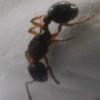I found these queens in the same general vicinity within a few weeks of each other.
SPECIES #1
Found 7 of these the other day. 1 of them managed to escape and is hiding somewhere in my room. ![]() Any help is appreciated.
Any help is appreciated.
1. Location of collection – Everett, WA.
2. Date of collection – Thursday, 8/27/15 around 8pm.
3. Habitat of collection – Puget trough
4. Length – 6mm
5. Coloration, hue, pattern and texture – Brownish. Tips of antennae and legs are lighter than body. Sort of shiny, but upon closer inspection there is dense pubescence. Has some longer hairs on the thorax and gaster. Mandibles are red.
6. Distinguishing characteristics –
7. Anything else distinctive – I could definitely be wrong, but I have a feeling these ladies are polygynous. (Please let me know ASAP if they aren’t!!) They sit next to and on top of each other all day. I frequently see them grooming each other. They also really like my heating cable.
8. Nest description – In my backyard underneath bamboo leaves. I found them at the end their nuptial flight walking through grass. Their nest is located next to a large dirt pile which is on top of sand. The actual nest was a small dirt pile and bamboo leaves were scattered all over it. I saw lots of workers, however I wasn’t quick enough to grab any.







SPECIES #2
Found 1 of these. She has 4 eggs so far. I caught her as she was looking for a place to settle down. Her wings were already removed.
1. Location of collection – Everett, WA.
2. Date of collection – Mid-August around 6pm.
3. Habitat of collection – Puget trough
4. Length – 11mm
5. Coloration, hue, pattern and texture – See pictures. Dense pubescence, almost furry looking. After feeding honey, her gaster expanded at least 3mm.
6. Distinguishing characteristics –
7. Anything else distinctive – Slow moving. She isn't disturbed very easily. Stays in same position all day.
8. Nest description –
Before feeding honey:




After feeding honey:




Edited by myrmecophile, September 1 2015 - 11:47 AM.















